Published in the March 2011 issue of a“Die Porsche Kassette”


September 17th finally arrives and I hitch my track trailer to my Boxster and head on out to Sebring with my good friend Bob, who will also be tracking his Boxster S.
Since we came in on Friday afternoon, we were able to choose our garage space at the track and immediately got to work installing the racing brake pads and the sticky tires. I now have a functioning brake caliper setup: 996 calipers and rotors up front with stock 986 calipers and rotors in the rear.
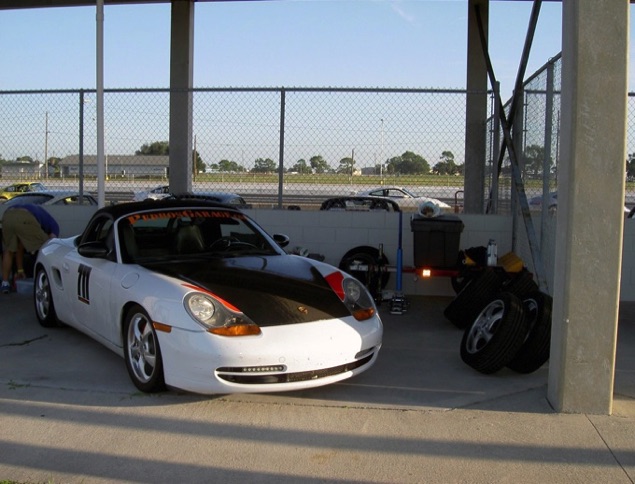
Next morning, as soon as the track opens (7:00 AM) we make it to our garage and I see Sebring’s first message: “Don’t mess with me”. A small green puddle under my car’s engine. I immediately dismiss this knowing that because the car had been idle for so long it was likely a small water pump leak that would go away as soon as I ran the car.
We go to the driver’s meeting. We’re the third group out, so we have to wait. After an eternity, it seems, we get the call for our run group to grid.
Again, we start slowly to get the feel of the rack and to warm things nicely.
The first session was very nice. No issues and the car ran great. The brakes were sweet.
I park it and there is no more coolant leak. All is good. I’m happy.
We start prepping for the next run and I go to clean my convertible’s rear plastic window which was slightly smudged. As I put a bit of pressure on the towel, the stitching just let’s go and half of the plastic rear window is now caved in and just hanging there. I think this is Sebrings 2nd message: “I already told you, don’t mess with me”. I know that I’ll be black flagged if I try to run like that so I have two options: Rip out the whole window (I don’t want to because, what if it rains on the way home?) or put the top down to go on the track, but then I need arm restraints which I don’t have. Luckily, there’s a nice race shop right on the premises and I’m able to find a set of arm restraints. The rules state that arm restraints are needed for open convertibles or cars with no top. I’d never run with them before, but I’m sure I’ll be fine.
Our group is up and we hit the track again. Since I have one of the smaller displacement engines in the group (2.5L) I’m prepared to point-by a lot of cars, including a few GT3s.
As the first GT3 comes up behind me I instinctively go to raise my left hand to point him by and all I can muster is a weak, index finger point-by which I’m sure he didn’t see. My arms are tied! I can see in my rearview mirror that he’s visibly upset! I loosened the restraints a bit and was able to marginally indicate on which side I wanted him to pass. He gives me the one-fingered salute as he blows by.
It was a struggle for a couple of laps but then I decided to do the point-bys with my turn signal indicators, as we do on the night DEs. Since we were in the Solo (Yellow) group, most of the other drivers immediately picked up on this and we were fine for the rest of the session.
This is fun!
The afternoon quickly arrives and we get called again for our last run of the day. Again we do the same routine. Grid – green flag – warm up laps.
I’m now about 15 minutes into the session, going through Bishops at WOT when I feel a slight but weird engine vibration. It quickly goes away. I go through 15 and as I apex turn 16 and accelerate, the engine shudders and dies! “Not again!” I yelled out loud.
I shift into neutral, remove my left arm restraint and raise my left arm indicating to the rest of the peloton that I’m heading in. I had carried enough speed into 16 that I was able to coast all of the back straight, make it around 17 and half way up pit lane. A couple of guys in the pits helped me push it the rest of the way.
Now at my garage I try to figure out what happened.
I try to start the engine a couple of times and it doesn’t want to. I connect a PIWIS unit loaned to me by Bert Smith Porsche who had some techs at the track that day, and all it says is that there was a misfire on cylinder 1 and cylinder 4 (simultaneously). I figure that the only way this happens is because of fuel starvation, but my gas tank is half full! Again I try to start the engine repeatedly and it won’t catch. Well, it must be the fuel pump, I think. I call a guy who has a large Porsche Shop in South Florida and tell him what happened. He concurs with the diagnosis and tells me that to be sure I should try to squirt some starter fluid into the intake to see if it fires. I find some which one of the guys in the next garage had, give it a good squirt and it starts! I call him back and he says that he has a spare fuel pump if I want it. He had just pulled it from another Boxster. Since I was stuck there anyway, I asked Bob if we could take a “quick” drive to pick up the fuel pump. He says “sure” and we jump into his red Boxster S and head south. We get to the shop around 8:30PM. No time to chat. I grab the pump, thank the shop owner and jump back in Bob’s Boxster to head back to Sebring. We have another 150 miles to go.
By the time we reach the track it’s now 10:30PM. Everyone is gone to their respective hotels or campers and the garages are dark. We line up Bob’s car and turn on his headlights to give us some working light and immediately start removing the battery and the battery’s base plate to access the top of the fuel tank, where the pump is submerged.

By midnight my right arm is completely immersed in gasoline as I struggle to remove the submerged fuel pump. Bob takes several steps back and looks scared.
The pump is finally out! I take the “new pump” and ...
... it won’t fit. Apparently the pump we brought back was for a 2.7. Mine is a 2.5.
Almost in despair, I look at the old pump and decide to test it. It kind of runs, but it’s very dirty. It’s been there for almost 200,000 miles, so it has pumped about 10,000 gallons of gasoline. We disassemble the complete carrier and clean things out. Now it’s clean and it’s going back in. By 3:30 AM we decide to call it quits after everything is in and the engine still won’t start.
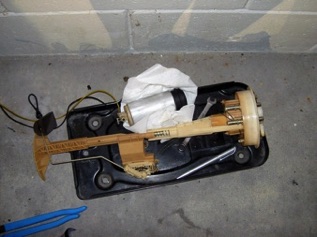
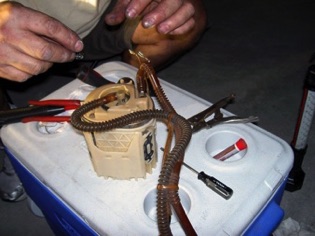
We decide to head back to the hotel and catch a couple of hours sleep.
By 7:30 AM we’re back at the track.
Unfortunately, today is not about tracking, but about getting back home.
We have a dead Boxster, a track trailer and a running Boxster (without a hitch).
It’s Sunday morning. I call the shop owner at home to see if I can borrow his car hauler that I’d seen at back at the shop last night. He says yes and we decide to meet at his shop around 1:00PM.
Bob and I decide to find an electric drill to install my hitch on his car. We do and leave my car in the garage and we head on south in Bobs car, towing my track trailer (with no wiring, therefore no lights).
We stop at my house, drop the little trailer off and head on over to Bob’s (another 30 miles) so I can borrow his Yukon (which used to be mine at one time). Bob can’t come back with me because he has a business flight to Germany that afternoon which he doesn’t want to miss. He tells me that a couple of times on our way down. I think it’s because he has a visit planned to the Porsche Museum.
We finally get to his house, I take the Yukon and head on over to pick up the trailer. From there I head on back to Sebring, trying to make it to the track before it closes, because I’ll need some help pushing my dead car onto the enclosed car hauler.
I get to the track around 5:30PM and luckily there are still a few guys there who help me load my car. I head on home, arriving at 9:00PM.
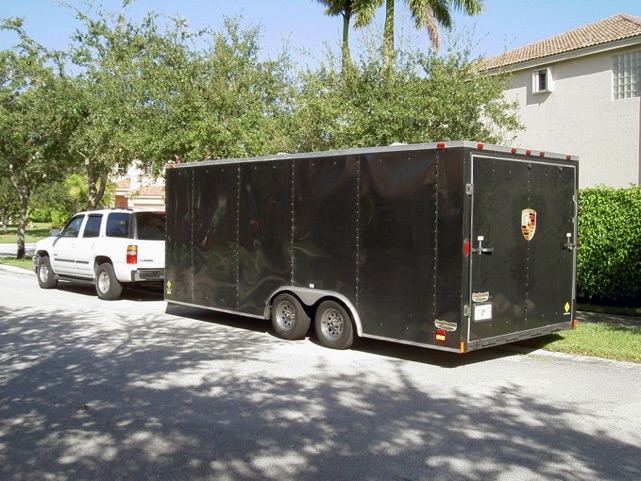
The next day, the post-mortem on my engine is performed and we find out that piston #6 is not moving when the engine is manually cranked. We’ll need a new engine. Piston rod #6 broke because of oil starvation.
MYTH #5
Boxsters and Caymans will develop oil starvation when run hard with sticky tires on fast, sweeping flat tracks (such as Sebring).
Well, this one busted us. It’s true!
Because I had spent so much money back in May, my funds were sort of depleted. I need a cheap engine. Checking with all of the usual suspects, the cheapest I find is $5200. Too much. I need to keep on looking. A couple of weeks go by and my legs are really strong now. I’ve been riding my bike to run errands around town. Finally, on week number 3 an engine appears on the famous auction site for $2,000. I can afford that, so I “Buy it Now” and wait for it to ship.
Now the problem is how to install it on my car because that engine is a 2.7 liter from a 2001 car. It is an e-gas engine which means no throttle cable which is not what my car has. Also the DME (engine management system) is completely different from mine. What to do?
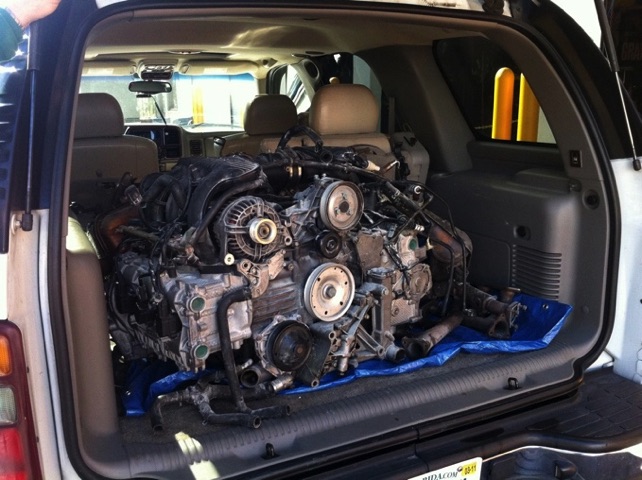
After much consideration and studying existing engines at the shop, the decision is made to first see in what condition the heads from the 2.5 are in, and if they are acceptable, then we’ll try to install them on the new block.
Except for a couple of bent valves over cylinder 6, everything seems fine. We send the heads out to be cleaned and pressure tested while we receive the 2.7 liter engine which gets taken apart.
New bearings, new seals and new piston rings go in. The cylinders look great.
The recently installed IMS bearing retrofit gets pulled out from the old IMS and it’s pressed onto the 2.7’s intermediate shaft.
Then, with new gaskets, the old, clean 2.5 liter heads get bolted onto the 2.7 liter block.
Everything fits like a glove. The new “hybrid” goes back into the car. Everything gets connected, fluids get replaced and ...
... varoom! it works.
MYTH #6
Engine heads must match the engine’s block.
Not true, our car is proof that you can and it is running great with no “Check Engine Light” warning.
I can tell you, that the “hybrid” has much better torque than the old 2.5 and I’m getting about 2 more miles-per-gallon than before.
I started the new year with a DE at PBIR, but since the “new” engine was still under break-in I really didn’t red line it or go flat out. Before I do that, an Accusump System will be installed to prevent the oil starvation issues and hopefully this new setup will give me another 200,000 (s)miles
I’ll let you know how that goes in a future article.
For more information on these and other Porsche issues, please visit my website at www.PedrosGarage.com
Happy Porsche-ing,
© 2011 Technolab/PedrosGarage.com

